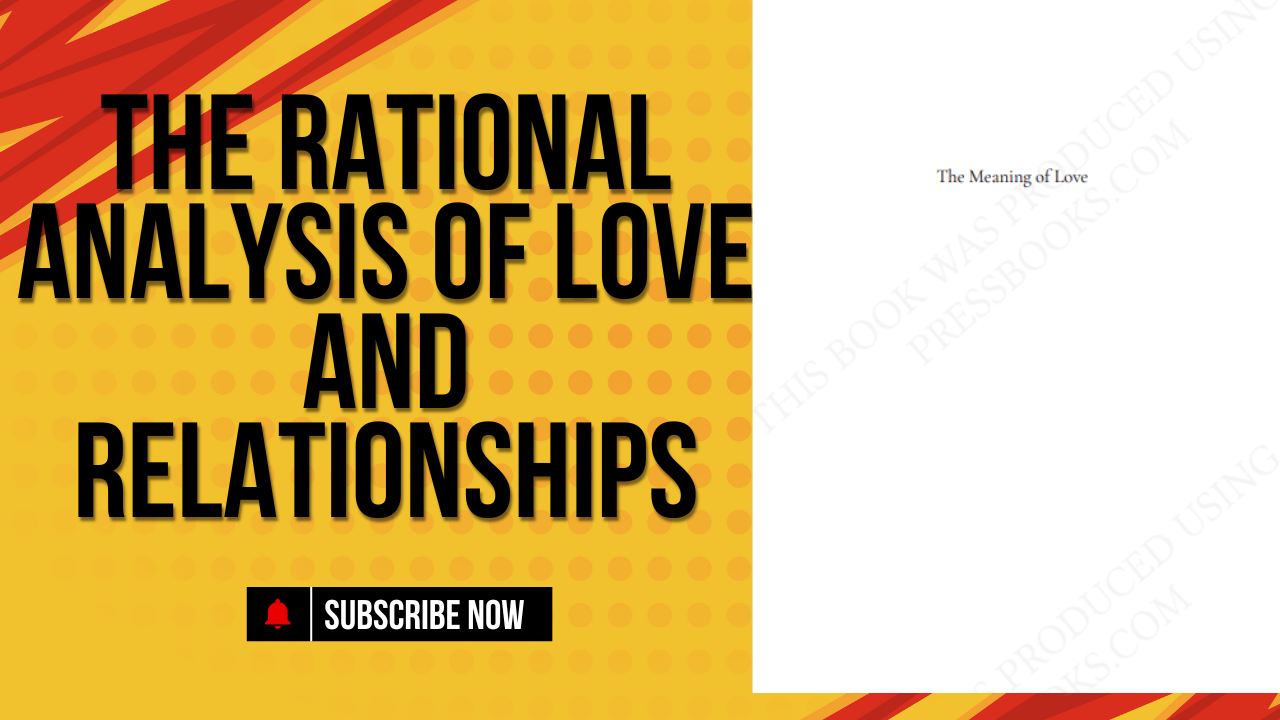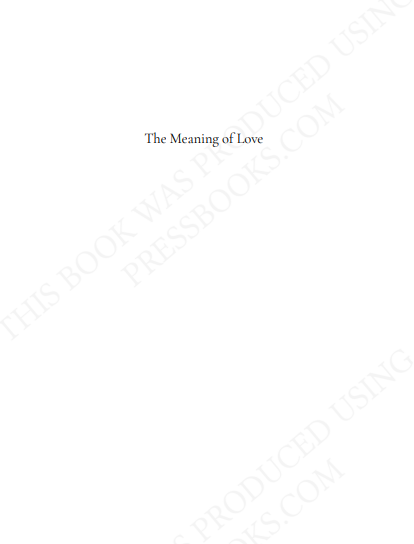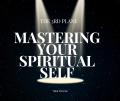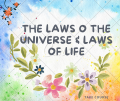
This text is an excerpt from a book that proposes a rational analysis of love, defining it as a combination of feelings of attraction, enjoyment (satisfaction), and ethical goodness within a relationship. The author examines these three components individually and explores their independence from one another, contrasting this rational approach with other common perspectives on love. Further, the text investigates various related concepts like infatuation, commitment, jealousy, and the importance of individuality within relationships, while also introducing ethical considerations and their application to interpersonal dynamics. Finally, the author discusses the views of other writers on love, comparing and contrasting them with their own analysis.

Exploring Love, Relationships, and Ethics
- How does this text distinguish between different types of relationships, and why is that distinction important?
- This text categorizes relationships based on three independent aspects: the emotional aspect (feelings of attraction or aversion), the satisfaction aspect (how agreeable or disagreeable a relationship is), and the ethical aspect (whether the relationship is “good” or “bad” in a moral sense). This separation allows for a clearer understanding of why a relationship might be satisfying but ethically questionable, or why someone might be attracted to someone they find generally disagreeable. It moves past simplistic notions of relationships as purely based on feeling.
- What are the different types of feelings or attractions described in the text, and how do they relate to each other?
- The text identifies a wide range of attractions including intellectual, physical (which may or may not be sexual), sexual, emotional, romantic, and attractions born from loneliness or sympathy. These attractions exist in various degrees and can even be felt simultaneously with aversions. For example, someone might be intellectually attracted but sexually repelled by the same person, or vice versa. The text also clarifies that there is a distinction between feeling attracted to a person’s physical appearance and experiencing a sexual attraction to them.
- The text describes “half-wishes” in relation to relationship satisfaction. What does that mean?
“Half-wishes” refer to the pleasures and disappointments that arise from our desires. The idea is that satisfaction is not just about fulfilling basic needs, but is instead about how well our half-wishes are met. For example, having sex may fulfill a basic need, but it is the manner and kind of sex that actually creates the most meaningful satisfaction. Half-wishes can extend to specific preferences for music, food, or forms of conversation, that are only fully satisfying when met in the particular way we had envisioned. This speaks to the complex and nuanced nature of satisfaction.
- How does the text address the complexities of sexual attraction and behavior, particularly in relation to love and commitment?
- The text distinguishes between sex with love, sex without love (but with desire), and sex without either love or desire (sometimes performed as a kind of “favor” in committed relationships). It also emphasizes that sexual desire can fluctuate independently of love or general attraction. The text argues that sex within marriage does not give a “blanket” moral right and that coercion is wrong, but also explores the concept that sex can be part of a meaningful relationship that may not be necessarily a long term romantic commitment, for example, between people who are about to be separated by death or circumstance. There is also a focus on the importance of partners understanding what sex means to each other before engaging in it to avoid conflict.
- What does the text say about the concept of “being used” sexually?
- The text argues that sexual use is not simply about one person being more active and the other being passive. Instead, it identifies circumstances where one partner is taking advantage of the other. This could involve coercing someone who is not in the mood, manipulating them through drugs or alcohol, or using someone’s temporary emotional state such as loneliness, depression, or a recent rejection to initiate a sexual encounter that is unlikely to lead to real satisfaction. It also highlights that both men and women can be either the “user” or “used” in such situations and challenges traditional gender roles often associated with these dynamics. The use of language and the perceptions around that language are also a factor here.
- How does the text approach ethical decision making, and what principles does it emphasize?
- The text explores different ethical theories, including egoism, hedonism, and utilitarianism, and while recognizing some validity to each, it critiques those that ignore important relational or moral considerations such as those based on duty, fairness, and promises. It argues that moral decisions should consider consequences as well as the intrinsic value of things like keeping one’s word and respecting others. The text challenges the idea that there is only one good or correct solution and acknowledges that situations can have more than one possible right action, while other times one may be wrong. Furthermore, the text rejects that something should be done simply because it is the wish of a person or majority as there are many situations in which a person or group’s wishes are ultimately bad for them and others. It is more than desires that should be considered.
- What does the text mean when it argues that “acceptance or rejection should not generally be taken as a reflection of just you alone, but of the two of you in combination”?
- This statement emphasizes that compatibility and relationship success are not solely determined by the characteristics of one person, but instead, by the interplay of character, chemistry, desires, and tastes of both people involved. It highlights that someone who is incompatible with one person might be very compatible with another without either party changing at all. This idea encourages people not to take rejection too personally but to consider it as an indication that there is incompatibility between the combination of people.
- What does the text say about the nature of feelings and how much we understand about their causes?
- The text acknowledges that while feelings and attractions play a large part in human relationships, they are not always well-understood, especially when considering the fact that we don’t always choose who we are attracted to. They are not always within our control. It is unclear why people are attracted to one person and not another even if the two people are equally good. The text indicates that people should not feel like their feelings need to be defended but they also should not base their decisions about relationships solely on their feelings. Further, the text emphasizes that feelings for one person do not mean you have any fewer feelings left over for another person. They are not “subtractive.”
The Meaning of Love: A Study Guide
Quiz
- According to the text, what are the three main aspects of a relationship? The three main aspects of a relationship are the emotional, satisfaction, and ethical aspects. These aspects can be independent of each other, meaning a relationship can be strong in one aspect but weak in another.
- How does the author differentiate between attraction and aversion? Attraction involves wanting to be near or communicate with another person, while aversion involves the opposite, a desire to avoid contact with them. The text notes that one can experience both attraction and aversion toward the same person at the same time.
- Explain what the text means by “satisfaction aspect” in a relationship. The satisfaction aspect refers to how agreeable or pleasing one finds another person’s behavior. It’s a broad spectrum, ranging from very satisfying and pleasant to very dissatisfying and unpleasant; it encompasses various areas of life and not just sexual interaction.
- What is the main point the author makes about the nature of feelings in relationships? The author stresses that feelings occur in varying degrees and that many kinds of feelings, like sexual or intellectual attraction, exist on a continuum from aversion to intense attraction. Additionally, feelings toward one person do not subtract from the ability to feel for another person.
- How does the text address the concept of “half-wishes” in relation to satisfaction? The author uses the term “half-wishes” to discuss how we often have desires that we don’t fully realize until they are fulfilled (or not). These half-wishes highlight that what seems satisfying may not be in the end and satisfaction is quite complex.
- According to the text, does marriage grant a blanket moral right to sex? Why or why not? No, marriage provides a legal right to sex, but not a moral one. The author explains that other factors, such as one partner not being in the mood or other rational considerations, can make sex within marriage wrong despite being legally permitted.
- What does the text propose about the ethics of keeping promises? The text proposes that keeping promises is not for a divine entity but for the person the promise is made to and who is depending on you. Breaking a promise is unethical because it negatively affects the person who had a right to expect you would fulfill your promise.
- What is the author’s stance on psychological egoism, as described in the text? The author rejects psychological egoism, the view that people always act in their own self-interest. The text provides examples of when people act against their own interests and make sacrifices for others, which indicates that psychological egoism is not a true theory.
- How does the author analyze the idea of “being used” in a sexual relationship? The author examines “being used” sexually in cases where a partner takes advantage of another’s vulnerabilities, such as talking someone into sex through manipulation or exploiting a person’s loneliness or depression. It goes further than this to examine if one has sex while not wanting it or when one partner simply sees the other partner as an object.
- In the context of the text, what does “intimacy” mean in relation to relationships? Intimacy can mean that an experience meets the conditions for intimacy at the time, even if one person is mistaken about how the other is feeling. Intimacy is also understood as a shared experience between individuals that is not merely intimate for one but also the other.
Answer Key
- The three main aspects of a relationship are the emotional, satisfaction, and ethical aspects. These aspects can be independent of each other, meaning a relationship can be strong in one aspect but weak in another.
- Attraction involves wanting to be near or communicate with another person, while aversion involves the opposite, a desire to avoid contact with them. The text notes that one can experience both attraction and aversion toward the same person at the same time.
- The satisfaction aspect refers to how agreeable or pleasing one finds another person’s behavior. It’s a broad spectrum, ranging from very satisfying and pleasant to very dissatisfying and unpleasant; it encompasses various areas of life and not just sexual interaction.
- The author stresses that feelings occur in varying degrees and that many kinds of feelings, like sexual or intellectual attraction, exist on a continuum from aversion to intense attraction. Additionally, feelings toward one person do not subtract from the ability to feel for another person.
- The author uses the term “half-wishes” to discuss how we often have desires that we don’t fully realize until they are fulfilled (or not). These half-wishes highlight that what seems satisfying may not be in the end and satisfaction is quite complex.
- No, marriage provides a legal right to sex, but not a moral one. The author explains that other factors, such as one partner not being in the mood or other rational considerations, can make sex within marriage wrong despite being legally permitted.
- The text proposes that keeping promises is not for a divine entity but for the person the promise is made to and who is depending on you. Breaking a promise is unethical because it negatively affects the person who had a right to expect you would fulfill your promise.
- The author rejects psychological egoism, the view that people always act in their own self-interest. The text provides examples of when people act against their own interests and make sacrifices for others, which indicates that psychological egoism is not a true theory.
- The author examines “being used” sexually in cases where a partner takes advantage of another’s vulnerabilities, such as talking someone into sex through manipulation or exploiting a person’s loneliness or depression. It goes further than this to examine if one has sex while not wanting it or when one partner simply sees the other partner as an object.
- Intimacy can mean that an experience meets the conditions for intimacy at the time, even if one person is mistaken about how the other is feeling. Intimacy is also understood as a shared experience between individuals that is not merely intimate for one but also the other.
Essay Questions
- Analyze the author’s argument for the independence of the emotional, satisfaction, and ethical aspects of a relationship. Provide examples of how a relationship can be strong in one aspect but weak in others, and discuss the implications of this independence.
- Discuss the author’s ethical framework concerning sexual relationships. Consider the factors used to justify and reject sex in different situations, especially the emphasis on mutual understanding and consent, and evaluate the author’s approach to these issues.
- Explain the author’s discussion of “being used” in relationships, including the various conditions and circumstances that constitute being used. How does the text present the idea that this is not necessarily gender specific?
- Explore the author’s critique of psychological egoism and the development of his ethical views. What examples does the author use to counter psychological egoism? Evaluate the importance of both the individual and the other in the author’s ethical framework.
- Consider the author’s examination of personal preferences and relationships, and in light of your reading, discuss the ways in which individuals must balance their own needs and desires with that of another within personal relationships.
Glossary of Key Terms
- Attraction: The desire to be in proximity or communication with another person.
- Aversion: The desire to avoid contact with another person.
- Emotional Aspect: The part of a relationship concerning feelings, such as love, affection, or dislike.
- Ethical Aspect: The moral dimension of a relationship, dealing with what is right or wrong behavior.
- Half-wishes: The sort of desire for something that one might not realize they want or would enjoy until it is experienced.
- Intimacy: A sense of closeness and connection in a relationship that is shared by the individuals.
- Psychological Egoism: The theory that all actions are ultimately motivated by self-interest.
- Satisfaction Aspect: The degree to which a relationship is pleasing or enjoyable based on behaviors of the partners.
- Supererogatory: A morally good or praiseworthy act that is not required or obligatory; “beyond the call of duty”.
- Act Utilitarianism: The ethical theory that an action is right if it produces the greatest good for the greatest number.
- STD: An abbreviation for Sexually Transmitted Disease.
- Fleeting Sexual Experience: A sexual experience that is short or temporary and often without long-term commitment or emotional involvement.
- Character: The sum of one’s moral qualities and behavior; something that often requires personal sacrifice to earn and keep.
- Making Love: A phrase used to describe the activity of having sexual intercourse, but in such a way that it emphasizes it is a reciprocal activity between two parties.






















0 responses on "The Rational Analysis of Love and Relationships"